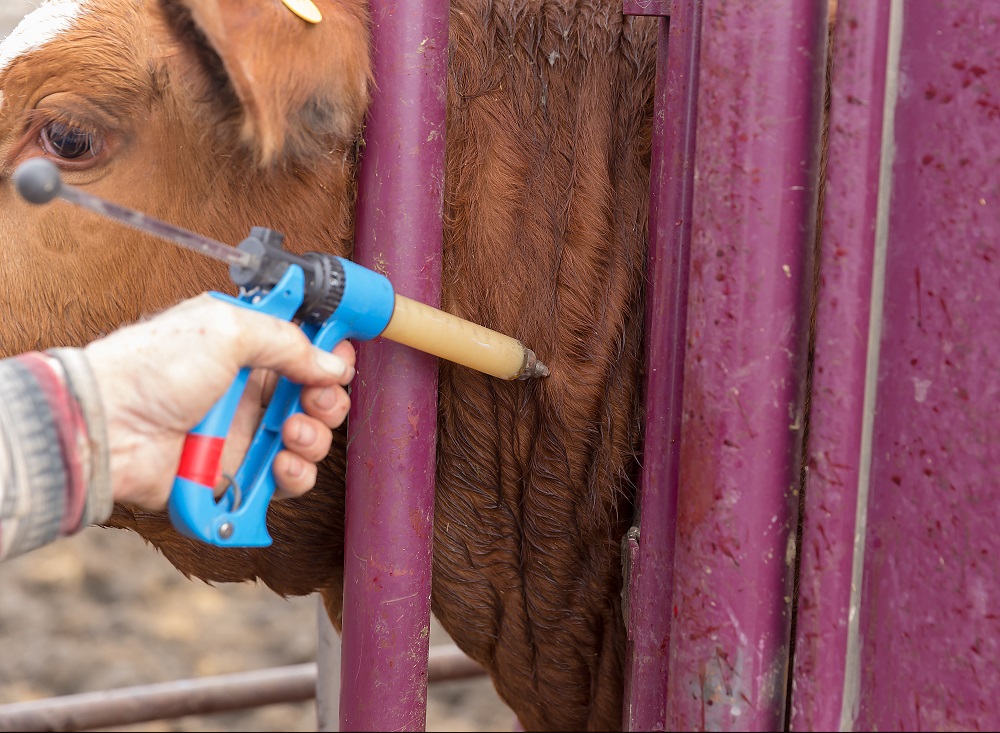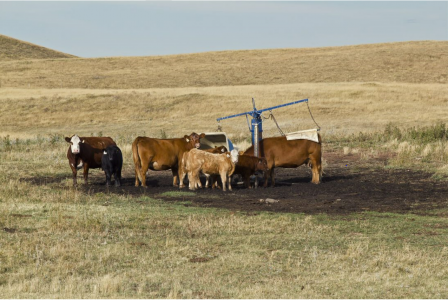Looking to Cut Costs this Spring? Think Twice Before Cutting Vitamins, Minerals and Vaccinations 🎙️
CLICK THE PLAY BUTTON TO LISTEN TO THIS POST:
Listen to more episodes on BeefResearch.ca, Spotify, Apple Podcasts, Amazon Music or Podbean.

With increasing input costs and many regions having poor growing conditions in recent years, there is pressure this spring to reduce input costs wherever possible. It is important to make these decisions carefully – sometimes the short-term savings are out-weighed by much greater long-term costs. Skimping on your cattle nutrition and vaccination programs may save you in the short term, but can set you up for long-lasting negative consequences.
Not meeting minimum nutritional needs increases treatment and death rates
While vitamin and mineral supplements may seem like an added or unwanted cost, maintaining or enhancing your nutrition program can help prevent both reproductive wrecks and sickness in the future.
Vitamin supplementation becomes even more critical during and after drought. Vitamins A and E come from leafy green plants, so these vitamins are likely to be deficient when cows are eating drought-impacted forages.
Calves born the spring following a drought have a much higher risk of vitamin A deficiency. Calves with severe vitamin A deficiency are nearly three times more likely to die than those with higher vitamin A levels. Vitamin A is available in an injectable form, but the typical vitamin A, D and E injectable supplement does not contain enough vitamin E to improve an animal’s mineral status. Vitamin E must be supplemented another way.
In addition to vitamins, mineral supplementation is also important. Previous work on western Canadian herds has shown that calves with low mineral levels at birth were six times more likely to be treated for pneumonia, scours or navel infection than their counterparts. In the same study, researchers found that calves born to cows with poor mineral status were also more likely to die before weaning.

Copper deficiency is an ongoing concern, especially in western Canada where soils tend to be deficient in copper. The risk can be even higher during a drought as feed and water both can be high in sulfates, which binds to copper and makes it less available to the animals. Copper deficiency can lead to reproductive wrecks. Adequate copper in your mineral program helps give cows their best chance to rebreed and produce healthy calves next year.
Talk to your nutritionist, veterinarian or local extension specialist about a vitamin and mineral program that is a good fit for your operation and location.
In extreme cases, injectable minerals can fix deficiencies much more rapidly than feed supplements. Your veterinarian can provide injectable minerals, but they may need to be imported from the United States or overseas.
Insufficient vaccination puts you at risk for a disease outbreak
Vaccinations may be another cost you are considering cutting, but this is risky. A survey of Canadian beef producers showed many producers justify not vaccinating because they believe they have a closed herd. Your herd is not closed and at risk for disease exposure if you:
- buy in any females or bulls,
- have fence line contact with other herds,
- use community pastures,
- expose your herd to wildlife or
- have any exposure to other cattle or places where cattle have been.
While the cost of vaccination may add up, it is cheap insurance to prevent large scale disease outbreaks and expensive losses associated with disease. The cost to treat a small number of calves or the death loss associated with even a small disease outbreak often outweigh the cost of a vaccine.
It’s tempting to cut corners on vaccinations, but consider the financial risks of taking that chance. On a 150-head cow-calf farm that fails to vaccinate, an “average” outbreak of bovine viral diarrhea virus (BVD) with 20% of the herd aborting will result in a financial hit of nearly $50,000. If the outbreak is severe and 59% of cows abort, that farm sustains an estimated loss of $138,500. Input your own on-farm numbers in the BCRC Cost-Benefit BVD Calculator to see how vaccination impacts your bottom line.
Here are some things to consider when talking to your veterinarian about a vaccine program for your herd:
- If you will be using a community pasture or other commingled grazing situation, reproductive diseases like vibrio or campylobacteriosis become more of a risk. Ask your vet about protecting your herd from these (and other) diseases.
- There is increasing evidence that providing intra-nasal vaccinations to calves at birth reduces the chance of sickness and death when calves go out to pasture.
- Pre-breeding is the ideal time to vaccinate your cow herd. However, other times of the year may be more practical for you and fit within the allowable times for vaccination. If you didn’t get around to vaccinating pre-breeding, or won’t have time, discuss alternative vaccination timing with your veterinarian.
Avoid long-term problems caused by short-term solutions
Beef producers continue to prove their resilience and creativity during challenging times. Reducing expenses can be a helpful management strategy, but choose wisely. Avoid cutting back on cattle nutrition and vaccination programs that can have dramatic, long-lasting and costly consequences.
Additional cattle nutrition and vaccination Resources
- Breeding Cow Management (BCRC webpage)
- Nutrition in Beef Cattle (BCRC webpage)
- More Questions on Mineral Nutrition (BCRC article)
- Consequences of Copper Deficiency (BCRC article)
- Drought and Mineral Nutrition (BCRC article)
- Abnormal Weather Doesn’t Grow Average Forage (BCRC article)
- Vaccination of the Beef Herd (BCRC webpage)
- Tips to Make the Most of Your Vaccine Protocol (BCRC article)
- BRD Vaccine Cost-Benefit Calculator (BCRC article)
- Intranasal Vaccines (BCRC article)
- Think You Have a Closed Herd (BCRC article)
- Protect Your Investments with Calf Vaccines (BCRC article)
Sharing or reprinting BCRC posts is welcome and encouraged. Please credit the Beef Cattle Research Council, provide the website address, www.BeefResearch.ca, and let us know you have chosen to share the article by emailing us at info@beefresearch.ca.
Your questions, comments and suggestions are welcome. Contact us directly or spark a public discussion by posting your thoughts below.